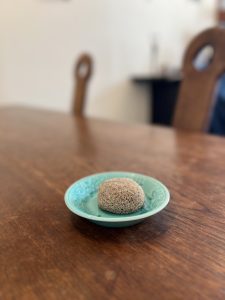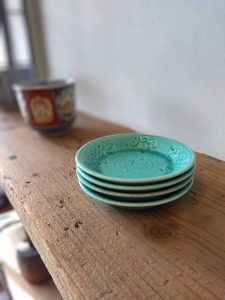けし餅をいただきました(愛知県名古屋市千種区姫池通 骨董買取 古美術風光舎)
2025.07.11
今日はプチプチした食感と柔らかいお餅のハーモニーが最高な「けし餅」をいただきました。

こしあんを餅でくるみ、けしの実を底まで全体にみっしりとまぶしてあります。お餅にみっしりとケシの実がついているのに、手に取ってもポロポロ落ちることがないのがすごい。
口に運ぶと、けしの実のプチプチとした食感とともに、香ばしさが広がります。こし餡とお餅はとても滑らかです。ケシの実が口の中でプチプチと良い食感がしますが、お餅から離れないので、口の中で粒が気になることもなく(これけっこう大事かも)食べられます。
茶席でも愛用されるというお菓子だけに、あんこはほどよい甘さ、餅も薄くて柔らか。けしの実は贅沢にまぶしてあって、とっても上品。冷たい緑茶と一緒にいただきましたが、相乗効果かおかわりできるものならなら何個でも食べられちゃいそうです。もちろん抹茶や煎茶、ほうじ茶とも相性抜群でしょう。
この「けし餅」は言わずと知れた大阪府堺市を代表する銘菓の一つですね。
あんぱんのトッピングでもお馴染みのけしの実は、堺が南蛮貿易の港町として栄え、海外からの珍しい産物が色々輸入された中の一つです。室町時代にインドからもたらされ、大阪、堺、和歌山周辺で盛んに栽培されるようになったそうです。
そして安土桃山時代に千利休によって広められた茶の湯の習慣は、堺の地で多くの和菓子を生み出し、その一つがけしの実の香味を生かして考案された『けし餅』だったとのこと。
ところで「ケシの実」は漢字で書くと「芥子の実」と書きますが、この芥子という漢字は「からし」「けし」「かいし(がいし)」の3通りの読み方があります。「からし」と聞くと「辛子」という漢字をイメージしますが、「芥子」でも香辛料の「からし」と同じ意味のようです。
「けし」は種類によってはアヘンの材料に使われるため、麻薬と意味を取り違えないよう、香辛料の「からし」は「辛子」と表記されてるとのこと。もちろん、料理に使う「からし」を「芥子」と書いても間違いではないようです。
そしてこの3通りの読み方、それぞれ状態で読み方が変わります。
芥子を「からし」と読むのは、アブラナ科の「芥子菜(カラシナ)」の種子を水で練って香辛料にした状態のものを指します。また「かいし(がいし)」とは、カラシナの種子のことを指し、医薬品の原料として使われることもあるそうです。最後に「けし」は高さ1.5mほどまで育つケシ科の植物を指します。
ちょっとややこしくなってきましたが、つまり芥子と表記されますが、ケシはケシ科、カラシはアブラナ科、全く違う2種類の植物ということです。芥子とは、カラシナとケシという植物のそれぞれの状態で読み方が異なるおもしろい漢字なのですね。
ところでカラシにもいろいろ種類がありますが、和カラシはカラシナ、洋カラシはシロガラシやクロガラシから作られるそうです。そしてシロガラシの種子は白芥子として生薬にも使われているとのことです…。なんだか何を調べていたのか分からなくなってきました…。
ちなみに七味唐辛子にはケシの実が入っておりますよ。
あーややこしい(笑)
ではでは、また。(スタッフT)

Today we had “Keshi Mochi,” a rice cake with the perfect harmony of soft and crunchy texture and soft rice cake.
Koshi An (sweet red bean paste) is wrapped around the rice cake, and poppy seeds are sprinkled all over the rice cake, even on the bottom. It is amazing that even though the rice cake is covered with poppy seeds, they do not fall off when you pick up the rice cake.
When you put it in your mouth, you can feel the crunchy texture of the poppy seeds as well as the savory aroma. The bean paste and mochi are very smooth. The poppy seeds have a nice texture in your mouth, but since they do not separate from the rice cake, you can eat it without worrying about the grains in your mouth (this may be quite important).
The mochi is thin and soft, and the sweet bean paste is just the right amount of sweetness, as it is also used in tea ceremonies. The rice cake is thin and soft, and the poppy seeds are lavishly sprinkled on top, making it very elegant. I enjoyed it with a cup of cold green tea, and I could have eaten as many as I could if I could have had another cup. Of course, it would also go well with matcha, sencha, or hojicha tea.
Keshi Mochi” is one of the famous confections representing Sakai City, Osaka Prefecture.
Keshi nuts, which are also a familiar topping for anpan (sweet bean buns), were one of the many rare products imported from overseas during Sakai’s prosperity as a port town for the Nanban trade. They were brought from India in the Muromachi period (1336-1573) and were actively cultivated in the Osaka, Sakai, and Wakayama areas.
The custom of tea ceremony spread by Sen no Rikyu in the Azuchi-Momoyama period (1573-1600) produced many Japanese confections in Sakai, and one of them was “Keshi Mochi,” which was invented by taking advantage of the poppy seed’s aroma.
By the way, “keshi no mi” (poppy seed) is written in Chinese characters as “keshi no mi,” which can be read in three different ways: “karashi,” “keshi,” and “kaishi (gaiji). The kanji for “mustard” conjures up images of the Chinese character for “hot pepper,” but ‘keshi’ seems to have the same meaning as the spice “mustard.
Since some types of “mustard” are used to make opium, the spice ‘mustard’ is written as “spicy” so as not to confuse the meaning with that of narcotics. Of course, it is not wrong to write “mustard” as “poppy” when it is used in cooking.
And each of these three ways of reading the word seems to change depending on the state.
The reading of “mustard” as “kara-shi” refers to the seeds of the mustard plant, a member of the Brassicaceae family, which are kneaded with water to make a spice. Also, “kaishi (gai-shi)” refers to the seeds of the mustard plant, which are sometimes used as an ingredient in medicines. Finally, “keshi” refers to a plant of the poppy family that grows up to 1.5 meters tall.
This is a bit confusing, but it means that although it is described as mustard, poppy is a member of the poppy family and mustard is a member of the Brassicaceae family, two completely different types of plants. The Chinese character for “mustard” is an interesting one, as it has different readings for the different states of the two plants, mustard and keshi.
By the way, there are various types of mustard, but Japanese mustard is made from karashina, while Western mustard is made from shirogalashi and kurogalashi. And the seeds of shirogalashi are used in herbal medicine as shirokeshi (white mustard).
By the way, shichimi chili contains poppy seeds.
Ah, it’s complicated (laughs).
Well then, see you. (Staff T)
*******************
ご実家の整理やお片付けなどをされている方のご相談などが多くございます。
お片付けなどくれぐれもご無理のないようになさってくださいませ。
風光舎では古美術品や骨董品の他にも絵画や宝石、趣味のお品など様々なジャンルのものを買受しております。
お片付けをされていて、こういうものでもいいのかしらと迷われているものでも、どうぞお気軽にご相談下さいませ。
また風光舎は、出張買取も強化しております。ご近所はもちろん、愛知県内、岐阜県、三重県その他の県へも出張いたします。
まずは、お電話お待ちしております。
愛知県名古屋市千種区姫池通
骨董 買取【古美術 風光舎 名古屋店】
TEL052(734)8444
10:00-18:00 OPEN

